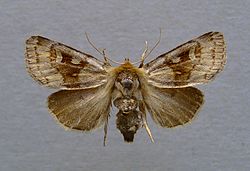| Xestia tecta | |
|---|---|
 | |
| Scientific classification | |
| Domain: | Eukaryota |
| Kingdom: | Animalia |
| Phylum: | Arthropoda |
| Class: | Insecta |
| Order: | Lepidoptera |
| Superfamily: | Noctuoidea |
| Family: | Noctuidae |
| Genus: | Xestia |
| Species: | X. tecta |
| Binomial name | |
| Xestia tecta (Hübner, 1808) | |
| Synonyms | |
| |
Xestia tecta is a species of moth in the family Noctuidae. In Europe, the species is only known from the boreal area of Fennoscandia, north-western Russia and the northern Ural Mountains. Outside of Europe it occurs in northern and central Siberia and the north-western USA including Alaska as well as north-western and central Canada.
Contents
The wingspan is 32–41 mm. Adults are on wing from June to August. The species takes two years to reach maturity.
The larvae feed on hardwood shrubs such as Huckleberries (Vaccinium spp.).